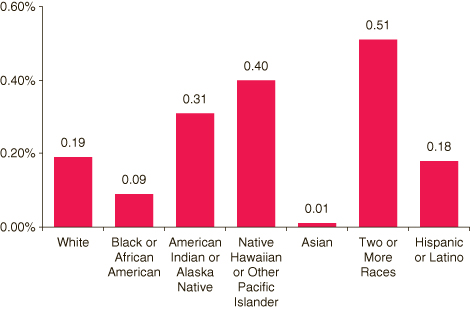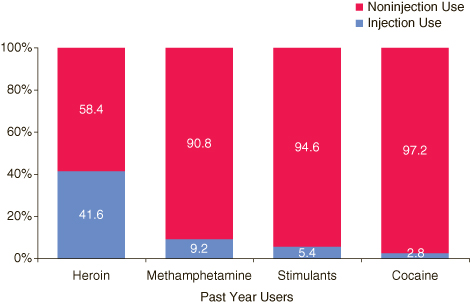
 |
| July 19, 2007 |
|
Combined data from 2002 to 2005 indicate that an annual average of 0.18 percent of persons aged 12 or older (an estimated 424,000 persons annually) injected heroin, cocaine, methamphetamine, or other stimulants in the past year. Males were twice as likely as females to have injected these drugs in the past year (0.24 vs. 0.11 percent). Rates of injection of these drugs in the past year among adults aged 18 to 34 were 3 times higher than the rates among youths aged 12 to 17 or adults aged 35 or older (0.34 vs. 0.10 and 0.12 percent, respectively). Past year injection of these drugs varied significantly among racial/ethnic groups, with the lowest rate among Asians (Figure 1). Whites were more likely than blacks to have injected these drugs in the past year. Overall injection drug use rates in the past year did not vary by county type or region.
 |
| Race/Ethnicity | Percent |
|---|---|
| White | 0.19% |
| Black or African American | 0.09% |
| American Indian or Alaska Native | 0.31% |
| Native Hawaiian or Other Pacific Islander | 0.40% |
| Asian | 0.01% |
| Two or More Races | 0.51% |
| Hispanic or Latino | 0.18% |
| Source: SAMHSA, 2002-2005 NSDUHs. |
Combined data from 2002 to 2005 indicate that an annual average of 0.09 percent of persons aged 12 or older (an estimated 206,000 persons annually) injected stimulants (which could include methamphetamine) in the past year, while 0.08 percent injected cocaine, 0.08 percent injected heroin, and 0.07 percent injected methamphetamine. Gender and age differences in injection use rates for the four respective drug types generally followed the overall patterns observed for injection of any of the drugs.
Persons living in non-metropolitan areas were approximately twice as likely to have injected stimulants or methamphetamine in the past year compared with persons living in large or small metropolitan areas (Table 1). Rates of past year injection of the four drug types also varied by region. Persons living in the Northeast were more likely to inject heroin than persons living in the Midwest or South; however, persons living in the Northeast were less likely to have injected methamphetamine in the past year than persons living in other regions. Rates of stimulant injection were higher in the West than in the Midwest or South and lower in the Northeast than in other regions.
| Characteristics | Heroin | Cocaine | Stimulants | Methamphetamine | |
|---|---|---|---|---|---|
| Metropolitan Area*** | |||||
| Large Metropolitan Area | 0.09% | 0.07% | 0.07% | 0.05% | |
| Small Metropolitan Area | 0.07% | 0.07% | 0.08% | 0.06% | |
| Non-Metropolitan Area | 0.05% | 0.10% | 0.15% | 0.13% | |
| Region+ | |||||
| Northeast | 0.13% | 0.07% | 0.05% | 0.02% | |
| Midwest | 0.05% | 0.07% | 0.08% | 0.05% | |
| South | 0.07% | 0.10% | 0.08% | 0.06% | |
| West | 0.09% | 0.06% | 0.14% | 0.12% |
| Source: SAMHSA, 2002-2005 NSDUHs. |
Combined data for 2002 through 2005 indicate that over two fifths of past year heroin users injected heroin in that period compared with a tenth or fewer of past year users of cocaine, methamphetamine, and other stimulants who injected these drugs (Figure 2). Among past year users of specific types of drugs, there were no gender differences in injection use. Among past year heroin users, for example, males and females were similar in the proportion who injected the drug in the past year (42.0 and 40.7 percent, respectively). Past year users of cocaine, stimulants, or methamphetamine who were aged 12 to 17 were less likely than past year users in other age groups to have injected these drugs in the past year. In addition, persons aged 26 to 34 who used cocaine or stimulants in the past year were more likely to have injected these drugs than were their counterparts who were aged 18 to 25 (cocaine: 4.3 vs. 2.1 percent; stimulants: 8.5 vs. 4.1 percent).
 |
| Heroin | Methamphetamine | Stimulants | Cocaine | |
|---|---|---|---|---|
| Noninjection Use | 58.4% | 90.8% | 94.6% | 97.2% |
| Injection Use | 41.6% | 9.2% | 5.4% | 2.8% |
| Source: SAMHSA, 2002-2005 NSDUHs. |
Among past year users of stimulants, those living in non-metropolitan areas were almost twice as likely to have injected the drug as users in large or small metropolitan areas (8.6 vs. 4.6 and 4.7 percent, respectively). Past year stimulant users in the West were more than 4 times more likely than users in the Northeast to have injected stimulants in that period (7.4 vs. 1.6 percent).
|
The National Survey on Drug Use and Health (NSDUH) is an annual survey sponsored by the Substance Abuse and Mental Health Services Administration (SAMHSA). Prior to 2002, this survey was called the National Household Survey on Drug Abuse (NHSDA). The 2002, 2003, 2004, and 2005 data used in this report are based on information obtained from 271,978 persons aged 12 or older. The survey collects data by administering questionnaires to a representative sample of the population through face-to-face interviews at their place of residence. The NSDUH Report is prepared by the Office of Applied Studies (OAS), SAMHSA, and by RTI International in Research Triangle Park, North Carolina. (RTI International is a trade name of Research Triangle Institute.) Information on NSDUH used in compiling data for this issue is available in the following publications: Office of Applied Studies. (2006). Results from the 2005 National Survey on Drug Use and Health: National findings (DHHS Publication No. SMA 06-4194, NSDUH Series H-30). Rockville, MD: Substance Abuse and Mental Health Services Administration. Office of Applied Studies. (2005). Results from the 2004 National Survey on Drug Use and Health: National findings (DHHS Publication No. SMA 05-4062, NSDUH Series H-28). Rockville, MD: Substance Abuse and Mental Health Services Administration. Office of Applied Studies. (2004). Results from the 2003 National Survey on Drug Use and Health: National findings (DHHS Publication No. SMA 04-3964, NSDUH Series H-25). Rockville, MD: Substance Abuse and Mental Health Services Administration. Office of Applied Studies. (2003). Results from the 2002 National Survey on Drug Use and Health: National findings (DHHS Publication No. SMA 03-3836, NSDUH Series H-22). Rockville, MD: Substance Abuse and Mental Health Services Administration. Also available online: http://www.oas.samhsa.gov. Because of improvements and modifications to the 2002 NSDUH, estimates from the 2002, 2003, 2004, and 2005 surveys should not be compared with estimates from the 2001 or earlier versions of the survey to examine changes over time. |
|
This page was last updated on July 11, 2008. |
|
SAMHSA, an agency in the Department of Health and Human Services, is the Federal Government's lead agency for improving the quality and availability of substance abuse prevention, addiction treatment, and mental health services in the United States. 
* PDF formatted files require that Adobe Acrobat Reader® program is installed on your computer. Click here to download this FREE software now from Adobe. |